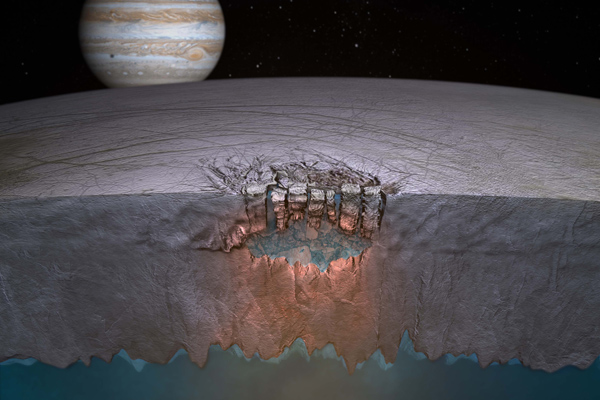November 28, 2011
Scientists find evidence for subsurface ‘great lake’ on Europa
‘Nature’ paper details potential new habitat for life on Jupiter’s icy moon

Artist’s impression of the ‘great lake’ on Jupiter’s moon Europa. Scientists speculate many more lakes exist throughout the shallow regions of the moon’s icy shell. Illustration: Britney Schmidt/Dead Pixel FX/ University of Texas at Austin
In a finding of significance in the search for life beyond Earth, scientists have discovered locked inside the icy shell of Jupiter’s moon Europa what appears to be a body of liquid water the volume of the North American Great Lakes, an area that could represent a new potential habitat for life.
In a Nov. 16 online article for the journal Nature, the researchers predict that many more such lakes exist throughout the shallow regions of Europa’s shell. Further increasing the potential for life is the finding that many of these lakes are covered by floating ice shelves that seem to be collapsing, providing a mechanism for transferring nutrients and energy between the surface and a vast ocean already thought to exist below the thick ice shell.
“The potential for exchange of material between the surface and subsurface is a big key for astrobiology,” said Wes Patterson, a planetary scientist at the Johns Hopkins University Applied Physics Laboratory and a co-author of the study. “Europa’s subsurface harbors much of what we believe is necessary for life, but chemical nutrients found at the surface are likely vital for driving biology.”
“One opinion in the scientific community has been, If the ice shell is thick, that’s bad for biology—that it might mean the surface isn’t communicating with the underlying ocean,” said Britney Schmidt, the paper’s lead author and a postdoctoral fellow at the University of Texas at Austin’s Institute for Geophysics. “Now we see evidence that it’s a thick ice shell that can mix vigorously, and new evidence for giant shallow lakes. That could make Europa and its ocean more habitable.”
The scientists focused on Galileo spacecraft images of two roughly circular, bumpy features on Europa’s surface called chaos terrains. Based on similar processes seen on Earth—on ice shelves and under glaciers overlaying volcanoes—they developed a four-step model to explain how the features form on Europa. The model resolves several conflicting observations, some of which seemed to suggest that the ice shell is thick and others, that it is thin.
While one of the chaos terrains appears to be fully formed, the other might still be forming, an indication that Europa’s surface is still geologically active.
“For quite some time, Europa geologists have been struggling to figure out what these features are and how they form,” said Louise Prockter, a senior planetary scientist at APL, who has conducted numerous studies of Europa. “This is the first time that anyone has come up with an end-to-end model that explains what we see on the surface.”
Observations of Europa from the Galileo spacecraft and of Earth give the scientists good reason to believe that their model is correct. Still, because the inferred lakes are several kilometers below the surface, the only true confirmation of their presence would come from a future spacecraft mission designed to probe the ice shell. Such a mission was rated by the National Research Council’s recent Planetary Science Decadal Survey as one of the highest-priority flagship missions and is currently being studied by NASA.
“If we’re ever to send a landed mission to Europa, these areas would be great places to study,” Prockter said.
In addition to Schmidt and Patterson, authors on the paper are Don Blankenship, senior research scientist at the Institute for Geophysics, and Paul Schenk, planetary scientist at the Lunar and Planetary Institute in Houston. The research was funded by NASA, the Institute for Geophysics at the University of Texas at Austin’s Jackson School of Geosciences and the Vetlesen Foundation.

